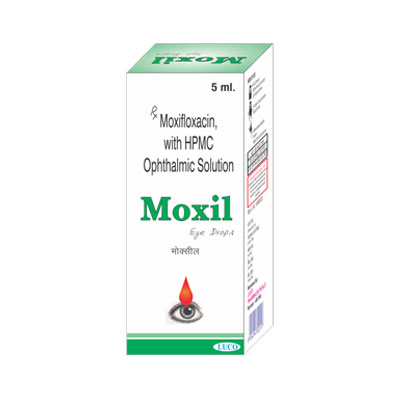
Moxifloxacin Hydrochloride Ophthalmic Solution 0.5% w/v
Moxifloxacin Hydrochloride Ophthalmic Solution 0.5% w/v is indicated for the treatment of bacterial conjunctivitis.
Trade Name :
Moxil
Moxifloxacin Hydrochloride Ophthalmic Solution 0.5% w/v
Composition :
Moxifloxacin Hydrochloride IP equivalent to Moxifloxacin 5 mg + Hydroxypropylmethyl Cellulose IP 0.25% w/v + Benzalkonium Chloride IP 0.02% v/v, Sterile Aqueous Base q.s.
Dosage Form :
Eye Drops
Indications :
Moxifloxacin Hydrochloride Ophthalmic Solution 0.5% w/v is indicated for the treatment of bacterial conjunctivitis caused by susceptible strains of the following organisms:
Aerobic Gram-positive microorganisms : Aerobic Gram-negative microorganisms
Cornyebacterium species* Acinetobacter Iwoffii*
Micrococcus luteus* Haemophilus influenzae
Staphylococcus aureus Haemophilus parainfluenzae*
Staphylococcus epidermidis
Staphylococcus haemolyticus Other microorganisms
Staphylococcus hominis Chlamydia trachomatis
Staphylococcus warneri*
Streptococcus pneumoniae
Streptococcus viridans group
*Efficacy for this organism was studied in fewer than 10 infections
Dosage and Method of Administration: :
Instill one drop in the affected eye 3 times a day for 7 days.
USE IN Special POPULATIONS :
Pregnant women :
Teratogenic Effects.
Pregnancy :
Category C
Moxifloxacin was not teratogenic when administered to pregnant rats during organogenesis at oral doses as high as 500mg/kg/day (approximately 21,700 times the highest recommended total daily human ophthalmic dose); however, decreased fetal body weights and slightly delayed fetal skeletal development were observed. There was no evidence of teratogenicity when pregnant Cynomolgus monkeys were given oral doses as high as 100 mg/kg/day (approximately 4,300 times the highest recommended total daily human ophthalmic dose). An increased incidence of smaller fetuses was observed at 100 mg/kg/day.
Since there no adequate and well–controlled studies in pregnant women, Moxifloxacin Hydrochloride Ophthalmic Solution 0.5% w/v should be used during pregnancy only if the potential benefit justifies the potential risk to the fetus.
Lactating Women :
Moxifloxacin has not been measured in human milk, although it can be presumed to be excreted in human milk. Caution should be exercised when Moxifloxacin Hydrochloride Ophthalmic Solution 0.5% w/v is administered to a nursing mother.
Geriatric Population :
No overall differences in safety and effectiveness have been observed between elderly and younger patients.
Carcinogenesis, Mutagenesis, impairment of Fertility:
Long term studies in animals to determine the carcinogenic potential of moxifloxacin have not been performed. However, in an accelerated study with initiators and promoters, moxifloxacin was not carcinogenic in rats following up to 38 weeks of oral dosing at 500 mg/ kg/day (approximately 21,700 times the highest recommended total daily human ophthalmic dose for a 50 mg person, on a mg/kg basis).
Moxifloxacin was not mutagenic in four bacterial strains used in the Ames Salmonella reversion assay. As with other quinolones, the positive response observed with moxifloxacin in strain TA 102 using the same assay may be due to the inhibition of DNA gyrase. Moxifloxacin was not mutagenic in the CHO/HGPRT mammalian cell gene mutation assay. An equivocal result was obtained in the same assay when v79 cells were used. Moxifloxacin was clastogenic in the v79 chromosomal aberration assay, but it did not induce unscheduled DNA synthesis in cultured rat hepatocytes. There was no evidence of genotoxicity in vivo in a micronucleus test or a dominant lethal test in mice.
Moxifloxacin had no effect on fertility in male and female rats at oral doses as high as 500mg/kg/day, approximately 21,700 times the highest recommended total daily human ophthalmic dose. At 500 mg/kg orally there were slight effects on sperm morphology (head-tail separation) in male rats and on the estrous cycle in female rats.
Contraindications :
Moxifloxacin Hydrochloride Ophthalmic Solution 0.5% w/v is contraindicated in patients with a history of hypersensitivity to moxifloxacin, to other quinolones, or to any of the components in this medication.
Warnings :
NOT FOR INJECTION. FOR EXTERNAL USE ONLY
In patients receiving systemically administered quinolones, including moxifloxacin, serious and occasionally fatal hypersensitivity (anaphylactic) reactions have been reported, some following the first dose. Some reactions were accompanied by cardiovascular collapse, loss of consciousness, angioedema (including laryngeal, pharyngeal or facial edema), airway obstruction, dyspnea, urticaria and itching. If an allergic reaction to moxifloxacin occurs, discontinue use of the drug. Serious acute hypersensitivity reactions may require immediate emergency treatment. Oxygen and airway management should be administered as clinically indicated.
Avoid contaminating the applicator tip with material from the eye, fingers or other source.
Precautions :
General :
As with other anti-infective, prolonged use may result in overgrowth of non-susceptible organisms, including fungi. If superinfection occurs, discontinue use and institute alternative therapy. Whenever clinical judgement dictates, the patient should be examined with the aid of magnification, such as slit-lamp bio microscopy, and, where appropriate, fluorescein staining.
Patients should be advised not to wear contact lenses if they have signs and symptoms of bacterial conjunctivitis.
Drug Interactions :
Drug-drug interaction studies have not been conducted with Moxifloxacin Hydrochloride Ophthalmic Solution 0.5% w/v. In vitro studies indicate that moxifloxacin does not inhibit CYP3A4, CYP2D6, CYP2C9, CYP2C19 or CYPlA2 indicating that moxifloxacin is unlikely to alter the pharmacokinetics of the drugs metabolized by these cytochrome P450 isoenzymes.
Undesirable Effects :
The most frequently reported ocular adverse events were conjunctivitis, decreased visual acuity, dry eye, keratitis, ocular discomfort, ocular hyperaemia, ocular pain, ocular pruritus, subconjunctival haemorrhage, and tearing. These events occurred in approximately 1-6% of patients.
Nonocular adverse events reported at a rate of 1-4% were fever, increased cough, infection, otitis media, pharyngitis, rash and rhinitis.
Pharmacological Properties :
Pharmacodynamics properties :
Moxifloxacin Hydrochloride Ophthalmic Solution 0.5% w/v is a sterile ophthalmic solution. It is an 8-methoxy fluoroquinolone for anti-infective for topical ophthalmic use.
Moxifloxacin is an 8-methoxy fluoroquinolone with a diazabicyclonyl ring at the C7 position. The antibacterial action of moxifloxacin results from inhibition of the topoisomerase II (DNA gyrase) and topoisomerase IV. DNA gyrase is an essential enzyme that is involved in the replication, transcription and repair of bacterial DNA.
Topoisomerase IV is an enzyme known to play a key role in the partitioning of the chromosomal DNA during bacterial cell division.
Mechanism of action :
Quinolones, including moxifloxacin, is different from that of macrolides, aminoglycosides, or tetracyclines. Therefore, moxifloxacin may be active against pathogens that are resistant to these antibiotics and these antibiotics may be active against pathogens that are resistant to moxifloxacin. There is no cross-resistance between moxifloxacin and the aforementioned classes of antibiotics. Cross-resistance has been observed between systemic moxifloxacin and some other quinolones.
In vitro resistance to moxifloxacin develops via multiple-step mutations. Resistance to moxifloxacin occurs in vitro at a general frequency of between 1.8 x 10-9 to < 1 x 10-11 for Gram-positive bacteria.
Moxifloxacin has been shown to be active against most strains of the following microorganisms, both in vitro and in clinical infections as described in the INDICATIONS section.
Aerobic Gram-positive microorganisms: Aerobic Gram-negative Microorganisms:
Cornyebacterium species* Acinetobacter Iwoffii*
Micrococcus luteus* Haemophilus influenzae
Staphylococcus aureus Haemophilus parainfluenzae*
Staphylococcus epidermidis
Staphylococcus haemolyticus
Staphylococcus hominis Other microorganisms:
Staphylococcus warneri* Chlamydia trachomatis
Streptococcus pneumoniae
Streptococcus viridans group
* Efficacy for this organism was studied in fewer than 10 infections.
The following in vitro data are also available, but their clinical significance in ophthalmic infections is unknown. The safety and effectiveness of Moxifloxacin Ophthalmic Solution 0.5% w/v in treating ophthalmological infections due to these microorganisms have not been established in adequate and well controlled trials.
The following organisms are considered susceptible when evaluated using systemic breakpoints. However, a correlation between the in vitro systemic breakpoint and ophthalmological efficacy has not been established. The list of organisms is provided as guidance only in assessing the potential treatment of conjunctival infections. Moxifloxacin inhibits in vitro minimal inhibitory concentrations (MICs) of 2mg/ml or less (systemic susceptible breakpoint) against most (90%) of strains of the following ocular pathogens.
Aerobic Gram-positive microorganisms:Anaerobic Microorganisms:
Listeria monocytogenes Clostridium perfringens
Staphylococcus saprophytipus Fusobacterium species
Streptococcus agalactiaePrevotella species
Streptococcus mitis Propionibacterium acnes
Streptococcus pyogenes
Streptococcus Group C, G and F
Aerobic Gram-negative microorganisms Other microorganisms:
Acinetobacter baumannii Chlamydia pneumoniae
Acinetobacter calcoaceticus Legionella pneoumophilia
Citrobacterfreundii Mycobacterium avium
Citrobacterkoseri Mycobacterium marinum
Enterobacter aerogenesMycopalsmapneoumoniae
Enterobacter cloacae
Escherichia coli
Klebsiellaoxytoca
Klebsiella pneumoniae
Moraxella catarrhalis
Morganellamorganii
Neisseria gonorrhoeae
Proteus mirabilis
Proteus vulgaris
Pseudomonas stutzeri
Clinical Studies :
In two randomized, double-masked, multicentre, controlled clinical trials in which patients were dosed 3 times a day for 4 days, Moxifloxacin Hydrochloride Ophthalmic Solution 0.5% w/v produced clinical cures on day 5-6 in 66% to 69% of patients treated for bacterial conjunctivitis. Microbiological success rates for the eradication of the baseline pathogen ranged from 84% to 94%. Please note that microbiologic eradication does rot always correlate with clinical outcome in anti-infective trials.
Pharmacokinetic properties :
Plasma concentrations of moxifloxacin were measured in healthy adult male and female subjects who received bilateral topical ocular doses of Moxifloxacin Hydrochloride Ophthalmic Solution 0.5% w/v 3 times a day. The mean steady state Cmax (2.7 ng/mL) and estimated daily exposure AUC (45 ng.hr/mL) values were 1,600 and 1,000 times lower than the mean Cmax and AUC reported after therapeutic 400 mg oral doses of moxifloxacin. The plasma half-life of moxifloxacin was estimated to be 13 hours.
Shelf Life :
15 Months
Packaging :
Opaque multi-dose vial, 5ml
Storage and Handling Instructions :
Store at 2°C – 25°C

OPHTHAL